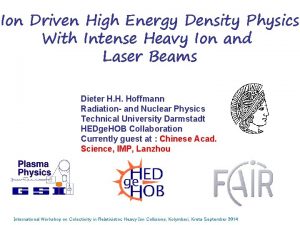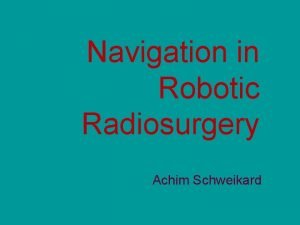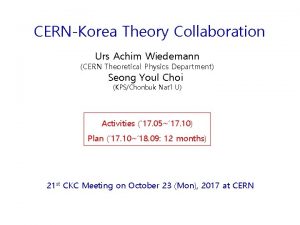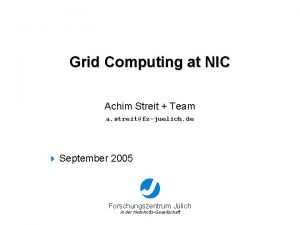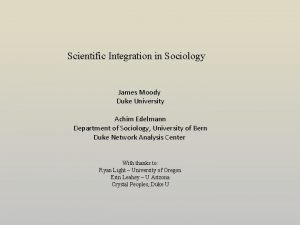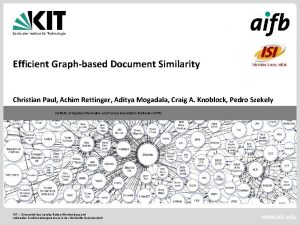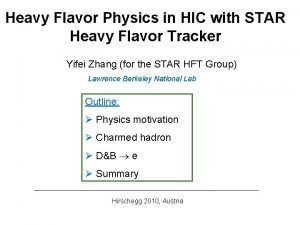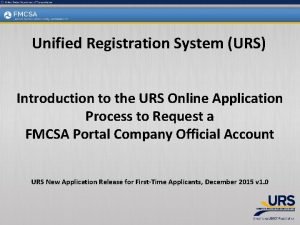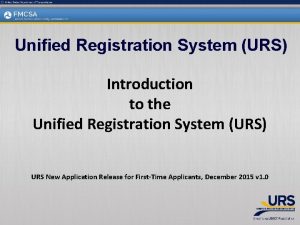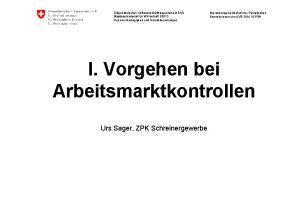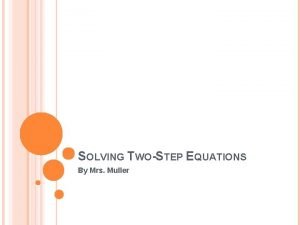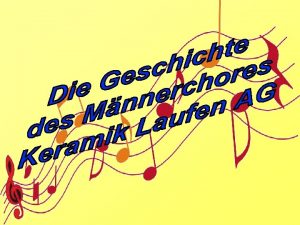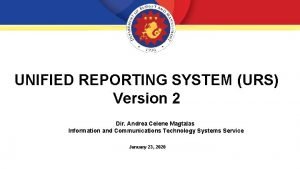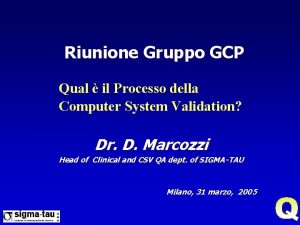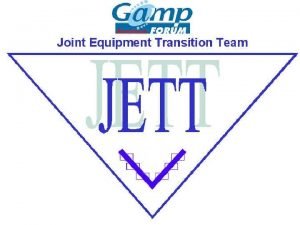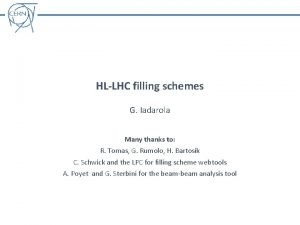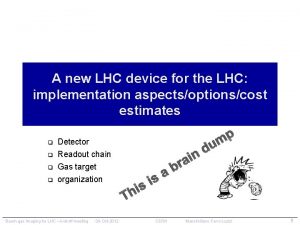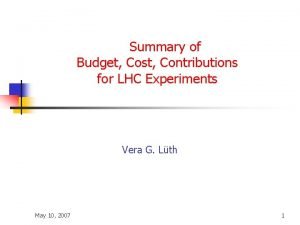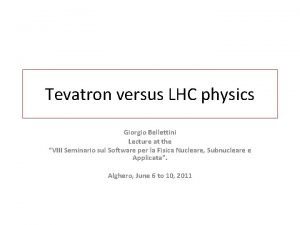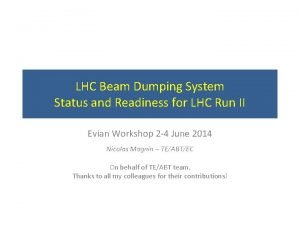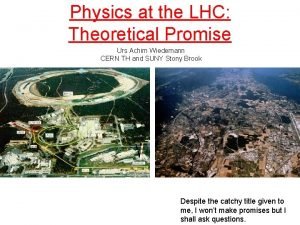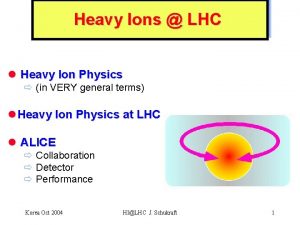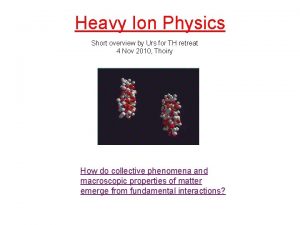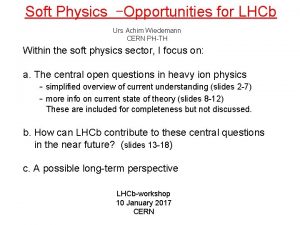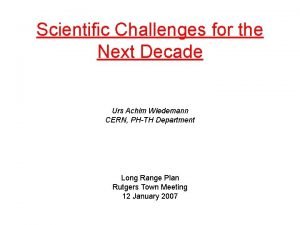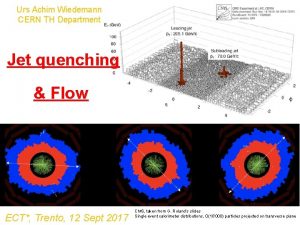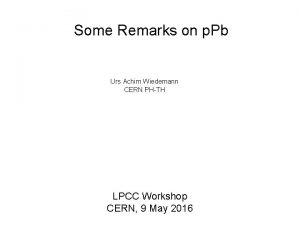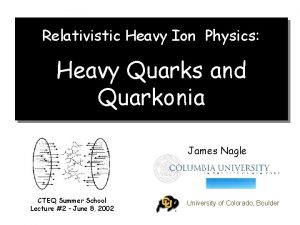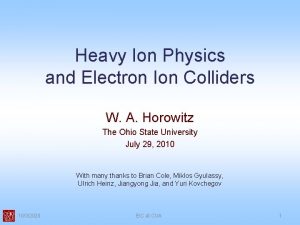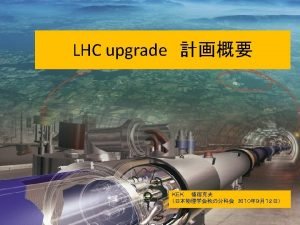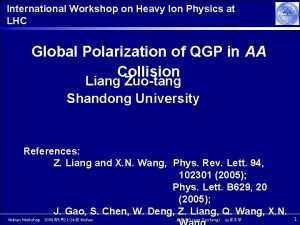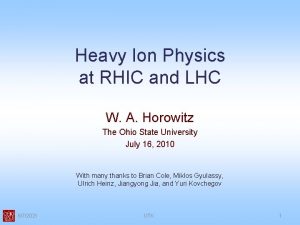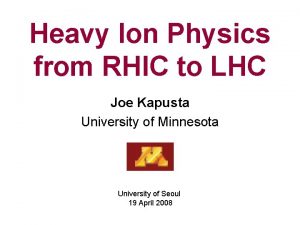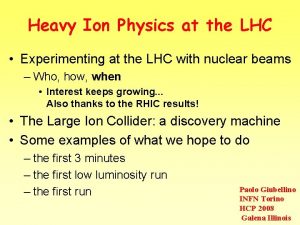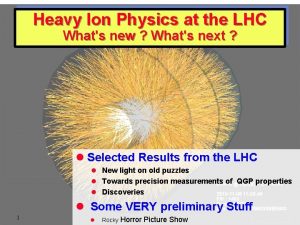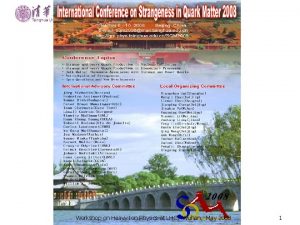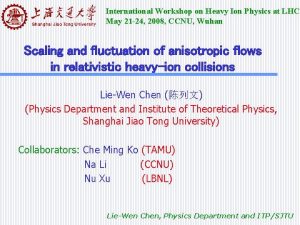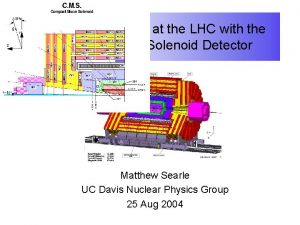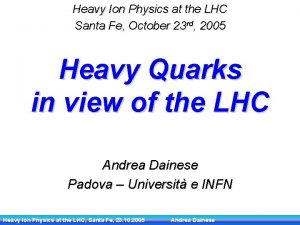Heavy Ion Physics at the LHC Urs Achim




































- Slides: 36

Heavy Ion Physics at the LHC Urs Achim Wiedemann CERN TH Partikeldagarna Stockholm 17 Oct 2008

From elementary interactions to collective phenomena 1973: asymptotic freedom QCD = quark model + gauge invariance Today: mature theory with a precision frontier • background in search for new physics • TH laboratory for non-abelian gauge theories How do collective phenomena and macroscopic properties of matter emerge from fundamental interactions? QCD much richer than QED: • non-abelian theory • degrees of freedom change with

Question: Why do we need collider energies to test properties of dense QCD matter which arise on typical scales ?

Answer 1: Large quantitative gains Increasing the center of mass energy implies Denser initial system Longer lifetime Bigger spatial extension Stronger collective phenomena A large body of experimental data from the CERN SPS and RHIC supports this argument.

Elliptic Flow: Hallmark of a collective phenomenon bounce squeeze

Particle production w. r. t. reaction plane • Single 2 ->2 process • Maximal asymmetry • NOT correlated to the reaction plane • Many 2 ->2 or 2 -> n processes • Reduced asymmetry • NOT correlated to the reaction plane • final state interactions • asymmetry caused not only by multiplicity fluctuations • collective component is correlated to the reaction plane

Particle production w. r. t. reaction plane ● Want to measure particle production as function of angle w. r. t. reaction plane But reaction plane is unknown. . . ● Have to measure particle correlations: “Non-flow effects” But this requires signals ● Improve measurement with higher cumulants: This requires signals Borghini, Dinh, Ollitrault, PRC (2001)

Elliptic flow: v 2 ● Momentum space: Reaction plane STAR Coll, Phys. Rev. C 66 (2002) 034904 ● 'Non-flow' effect for 2 nd order cumulants for 4 th order cumulants strong collectivity

Elliptic flow vs. hydrodynamic simulations Assumptions: - perfect (non-dissipative) liquid - Bjorken boost invariance - ‘realistic’ equation of state - ‘realistic’ initial conditions - ‘realistic’ decoupling (freeze-out) Results: - initial transverse pressure gradient - dependence of flow field elliptic flow - size and pt-dependence of data accounted for by hydro (‘maximal’) - characteristic mass dependence, since all particle species emerge from common flow field Strong claims at RHIC … Ideal hydro works Reaction plane Equal energy density lines PRC 72 (05) 014904 200 Ge. V Au+Au min-bias Kolb, Heinz; Teaney, Shuryak; Hirano, Nara; Huovinen


Elliptic flow is sensitive to viscosity

Viscosity: Bounds from theory • Viscosity controls entropy s increase • Hydrodynamics is valid, if • Constraint from string theory Arnold, Moore, Yaffe, JHEP 11 (2000) 001 Strong coupling limit of N=4 SYM Kovtun, Son, Starinets, hep -th/0309213

LHC 1 st year running tests hallmark of collectivity Generic trends in the data: What if they persist or fail? Hydro

LHC tests the hydro-paradigm • Hydro prediction for low LHC multiplicity • Extrapolation of generic RHIC trend Heinz, Kolb, Sollfrank N. Borghini, UAW (In)consistency with generic trend Characterization of microscopic dynamics underlying collectivity

Day 1 @ LHC: event multiplicity at y=0 PHOBOS, PRC 74 (2006) 021901; W. Busza. • generic trends in - extended longitudinal scaling - self-similar trapezoidal shape N. Borghini, UAW J. Phys. G 2007. • Saturation models predict Armesto, Salgado, Wiedemann, PRL 94 (2005) 022002 or Kharzeev, Levin, Nardi, NPA 747 (2005) 609. Both consistent with main trends at RHIC, but … Extrapolations to LHC deviate from so-far generic trends in data Impact for understanding the dynamical origin of soft physics at RHIC and LHC.

First year of Pb+Pb@LHC: - Physics not luminosity dictated - First characterization of collective phenomena at 5. 5 Te. V - Physics impact: Hydrodynamics? Hadrochemistry? Multiplicity distributions as first handle of saturation? Strong reasons to run Pb+Pb in 2009 even if run is short.

Question: Why do we need collider energies to test properties of dense QCD matter which arise on typical scales ?

Answer 2: Qualitatively novel access to properties of dense matter To test properties of QCD matter, largecontrolled tools (example: DIS). processes provide well- Heavy Ion Collisions produce auto-generated probes at high Q: How sensitive are such ‘hard probes’?

Bjorken’s original estimate and its correction Bjorken 1982: consider jet in p+p collision, hard parton interacts with underlying event collisional energy loss (error in estimate!) Bjorken conjectured monojet phenomenon in proton-proton But: radiative energy loss expected to dominate Baier Dokshitzer Mueller Peigne Schiff 1995 • p+p: Negligible ! • A+A: Monojet phenomenon! Observed at RHIC

Parton energy loss - a simple estimate Medium characterized by transport coefficient: ● How much energy is lost ? Characteristic gluon energy Phase accumulated in medium: Number of coherent scatterings: Gluon energy distribution: Average energy loss , where

The medium-modified Final State Parton Shower Baier, Dokshitzer, Mueller, Peigne, Schiff; Zakharov; Wiedemann… Radiation off produced parton Target average determined by light-like Wilson lines: BDMPS transport coefficient (only mediumdependent quantity) Reason for appearance of: High energy scattering = phase rotation in target color field

High p. T Hadron Spectra 0 -5% 70 -90% Centrality dependence: L large L small

Strong suppression persists to highest p. T 0 -5% L large 70 -90% L small Enhanced Centrality dependence: Suppressed

Centrality dependence: Au+Au vs. d+Au ● Final state suppression partonic energy loss ● Initial state enhancement

The Matter is Opaque • STAR azimuthal correlation function shows ~ complete absence of “awayside” jet GONE DF = p DF FPartner in hard scatter is DF=0 DF = 0 completely absorbed in the dense medium

The suppression of leading hadrons Parton energy loss calculations account for: • Nuclear modification factor • Centrality dependence • Back-to-back correlations • RAA = 0. 2 is a natural limit Eskola, Honkanen, Salgado, Wiedemann NPA 747 (2005) 511 Photons due to surface emission ? indicates very opaque medium. • Numerics at face value: Open questions: - tests of the microscopic dynamics underlying high-pt hadron suppression? - relation of to model-independent calculation in QCD?

Ad. S/CFT Numerology • In QGP of QCD, parton energy loss described perturbatively up to non-perturbative quenching parameter. • We calculate quenching parameter in N=4 SYM (not necessarily a calculation of full energy loss of SYM) Liu, Rajagopal, Wiedemann, 2006 • If we relate N=4 SYM to QCD by fixing for T = 300 Me. V for T = 400 Me. V This is close to values from experimental fits. Is this comparison meaningful?

Comment on: Is comparions meaningful? N=4 SYM theory • conformal • no asmptotic freedom no confinement • supersymmetric • no chiral condensate • no dynamical quarks, 6 scalar and 4 Weyl fermionic fields in adjoint representation Physics near vacuum and at very high energy is very different from that of QCD

At finite temperature: Is comparions meaningful? N=4 SYM theory at finite T QCD at T ~ few x Tc • conformal • near conformal (lattice) • no asymptotic freedom • not intrinsic properties of no confinement QGP at strong coupling • supersymmetric (badly broken) • not present • no chiral condensate • not present • no dynamical quarks, 6 scalar • may be taken care of by and 4 Weyl fermionic fields in adjoint representation proper normalization

How does a hard probe interact in the medium? How does this parton thermalize? Where does this associated radiation go to? What is the dependence on parton identity? Characterize Recoil: What is kicked in the medium? Jet multiparticle final states provide qualitatively novel characterizations of the medium.

Jet modifications in dense QCD matter • ‘Longitudinal Jet heating’: The entire longitudinal jet multiplicity distribution softens due to medium effects. Borghini, Wiedemann, hep-ph/0506218 • Jets ‘blown with the wind’ Hard partons are not produced in the rest frame comoving with the medium Armesto, Salgado, Wiedemann, Phys. Rev. Lett. 93 (2004) 242301

JEWEL: Jet Evolution With Energy Loss Disentangling radiative & collisional mechanisms K. Zapp, G. Ingelman, J. Rathsman, J. Stachel, U. A. Wiedemann, ar. Xiv: 0804. 3568 [hep-ph]

JEWEL: disentangling elas / inelas processes K. Zapp, G. Ingelman, J. Rathsman, J. Stachel, U. A. Wiedemann, ar. Xiv: 0804. 3568 [hep-ph]

Parton energy loss depends on parton identity • Vacuum and medium radiation is suppressed due to quark mass Dokshitzer, Kharzeev, PLB 519 (2001) 199 • To test this at the LHC, exploit: light-flavored mesons - gluon parents D - mesons - quark parents (mc~0) B - mesons - quark parents (mb>0) Armesto, Dainese, Salgado, Wiedemann, PRD 71: 054027, 2005 Massless “c, b” • Color charge dependence dominates • Mass dependence dominates Massive c, b

Jets in Heavy Ion Collisions at the LHC • The physics: ‘True’ jet rates are abundant at LHC. ‘True’ jets not in kinematical reach of RHIC. • The jet as a thermometer: jets as a far out-of-equilibrium probe participating in equilibration processes. • Sensitive jet features: - jet shapes (i. e. calorimetry) - jet multiplicity distributions (in trans. and long. momentum) - jet-like particle correlations - jet composition (i. e. hadrochemistry) • The challenge: characterize medium-modifications of jets in high multiplicity background. Prerequisite: determine ET-distribution of final state hadrons.

LHC: the richness of hard probes The probes: • Jets • identified hadron specta • D-, B-mesons • Quarkonia • Photons • Z-boson tags The range: , x, A, luminosity Abundant yield of hard probes + robust signal (medium sensitivity >> uncertainties) = detailed understanding of dense QCD matter
 What does ratey stand for
What does ratey stand for Hadrons
Hadrons Heavy ion
Heavy ion Achim stahl
Achim stahl Achim schweikard
Achim schweikard Achim wiedemann
Achim wiedemann Achim streit
Achim streit James moody duke
James moody duke Achim rettinger
Achim rettinger London forces vs van der waals
London forces vs van der waals Ion dipolo
Ion dipolo Qumica
Qumica Que es fuerzas intramoleculares
Que es fuerzas intramoleculares Heavy flavor physics
Heavy flavor physics Urs registration
Urs registration Urs fort rucker
Urs fort rucker Urs mexico
Urs mexico Urs portal
Urs portal Urs registration
Urs registration Ermächtigungsschreiben
Ermächtigungsschreiben Reverse pemdas
Reverse pemdas Unified registration system
Unified registration system Urs online application
Urs online application Urs kurth
Urs kurth Unified reporting system
Unified reporting system Urs stirnimann dubai
Urs stirnimann dubai Urs fs ds
Urs fs ds Gamp project
Gamp project Non-cmvs the applicant plans to operate
Non-cmvs the applicant plans to operate Unified registration system urs
Unified registration system urs Lhc filling scheme
Lhc filling scheme Lhc
Lhc Lhc budget
Lhc budget Bellettini
Bellettini Lhc plan
Lhc plan Hl-lhc schedule
Hl-lhc schedule Lhc beam dump
Lhc beam dump


